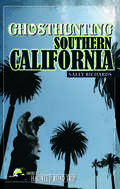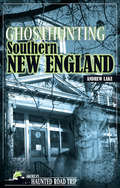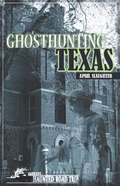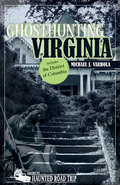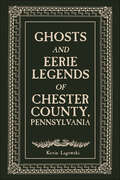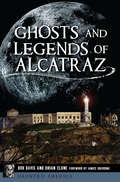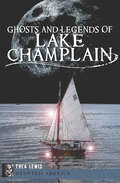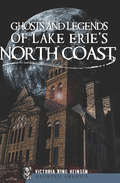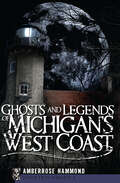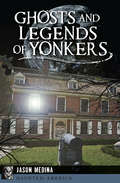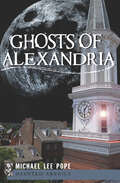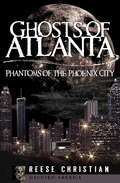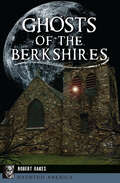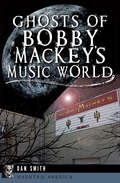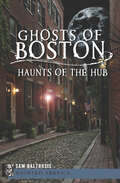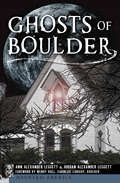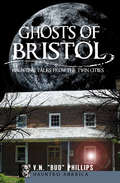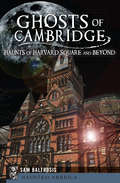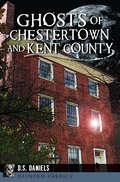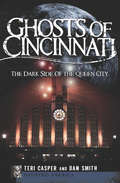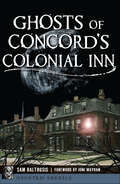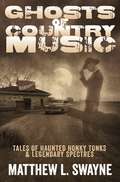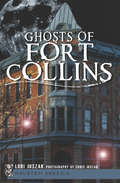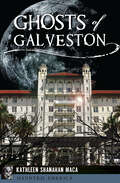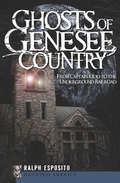- Table View
- List View
Ghosthunting Southern California
by Sally RichardsIn Ghosthunting Southern California author Sally Richards takes readers on an eerie journey through the region on a series of paranormal investigations to historic locations marred by tragedy and unfortunate happenstance that have caused the dead to rise. This collection brings well-known paranormal researchers, history, and evidence collected with state-of-the-art equipment together for chilling non-fiction accounts of haunted Southern California. The stories leave readers with a sense of deep interest to find out what lies in the murky darkness beyond. Sally Richards, historian, paranormal investigator, and spiritualist medium brings history alive as she investigates locations with high-profile paranormal experts using state-of-the-art equipment, historians, and people who share a similar curiosity of the paranormal to bring you the latest on "haunted" locations throughout Southern California. From the Mexican border to Santa Barbara, readers find chilling accounts of paranormal activity. Whether readers are veterans of ghost hunting, paranormal neophytes, or armchair travelers, this book offers fresh information and a style that puts readers right into the paranormal action.
Ghosthunting Southern New England
by Andrew LakeOn this leg of the journey you'll explore the scariest spots in Southern New England. Author Andrew Lake visits more than 30 legendary haunted places, all of which are open to the public-so you can test your own ghosthunting skills, if you dare.Join Andrew as he visits each site, snooping around eerie rooms and dark corners, talking to people who swear to their paranormal experiences, and giving you a first-hand account.Enjoy Ghosthunting Southern New England from the safety of your armchair or hit the road, using the maps, "Haunted Places" travel guide with 50 more spooky sites and "Ghostly Resources." Buckle up and get ready for the spookiest ride of your life.
Ghosthunting Texas
by John B. Kachuba April SlaughterThe Lone Star State is so vast it includes just about everything - including ghosts! This guide is divided into regions to make it easy to find the phantoms. North Texas offers such creepy destinations as the Old Alton Bridge and Miss Molly's Bed & Breakfast. West Texas spooks haunt the Permia Playhouse and Historic Fort Davis. In Central Texas, they've been spotted terrorizing the Driskill Hotel and the Austin Pizza Garden. More than 50 spooky sites are here, along with detailed maps and photographs of each haunted locale.
Ghosthunting Virginia
by Michael J. VarholaVirginia and the District of Columbia are fertile ground for serious and casual ghosthunters alike and have no shortage of venues for paranormal investigation - if visitors know where to look. Author Michael J. Varhola has spared no efforts to make Ghosthunting Virginia as useful a resource as possible for those interested in visiting haunted sites as he leads readers on a guided tour of the most haunted sites in the Old Dominion and the nation's capital. A great many of these sites have some connection to the Colonial era or to the Civil War, two defining elements in the history of the region. Battlefields, cemeteries, tunnels, caves, bridges, haunted highways, inns and taverns, lighthouses, theatres, haunted cities like historic Winchester, Colonial Williamsburg, and Washington, D.C, and all manner of other eerie locales can be found in this novel and informative travel guide! It's also perfect late-night reading for anyone who loves a good ghost story.
Ghosts and Eerie Legends of Chester County, Pennsylvania
by Kevin LagowskiThe hidden chronicles of Chester County are right underfoot or across the road every day, and much of it also has a certain lore attached that ventures into the spectral realm. • Hear the ticking tomb within a creepy, old cemetery • Experience the morbid Pennhurst State School and Hospital during the &“spooky season.&” • Learn about the haunted Phoenixville Library • Read about the unnatural and unholy Devil&’s Road • Consider a meal at the haunted Eagle (now Bloom Southern Kitchen) or Letty&’s Tavern From brick-and-mortar buildings to sprawling graveyards, battlefields, and ghost towns, this collection of more than 30 stories and historical accounts features the most-interesting anecdotes, tall tales, and—of course—ghost stories of yesteryear that have been passed down in local history. Complete with GPS directions, start your eerie road trip here.
Ghosts and Legends of Alcatraz (Haunted America)
by Bob Davis Brian CluneA pair of paranormal investigators share the supernatural stories surrounding the legendary California island prison. Alcatraz is one of the most infamous prisons in the world. Evil spirits, unknown beasts, vicious murderers and an untold number of ghosts all are said to reside on this tiny island in San Francisco Bay. Rufus McCain, who died a brutal death at the hands of a fellow inmate, is said to roam the grounds, and the basement cells used for solitary confinement were rumored to be so frightening that inmates who endured one stint never wanted to go back. Multiple escape attempts were thwarted, including two attempts by Sam Shockley, who was later executed with fellow inmate Miran Thompson. Join Bob Davis and Brian Clune as they explore chilling tales of death, murder and savagery from America's Devil's Island.
Ghosts and Legends of Lake Champlain (Haunted America)
by Thea LewisThe author of Haunted Burlington shares Lake Champlain&’s chilling history—from swashbuckling spirits to Champ, &“North America&’s Loch Ness Monster.&” Lake Champlain is located between New York&’s majestic Adirondacks and Vermont&’s famed Green Mountains. Yet despite the beauty of this region, it has been the site of dark and mysterious events; it is not surprising that some spirits linger in this otherwise tranquil place. Fort Ticonderoga saw some of early America&’s bloodiest battles, and American, French and British ghosts still stand guard. A spirit walks the halls of SUNY Plattsburgh, even after his original haunt burned in 1929. Champlain&’s islands—Stave, Crab, Valcour and Garden—all host otherworldly inhabitants, and unidentified creatures and objects have made appearances on the water, in the sky and in the forests surrounding the lake. Join Burlington&’s Thea Lewis as she explores the ghosts and legends that haunt Lake Champlain. Includes photos! &“For Lewis, a gifted storyteller, a good story makes a haunted place all the more compelling.&” —Happy Vermont
Ghosts and Legends of Lake Erie's North Coast (Haunted America)
by Victoria King HeinsenCall it Lake Eerie, according to this book &“filled with ghostly encounters of the friendly kind with a bit of local history mixed in&” (Toledo Blade). The residents of Lake Erie&’s North coast have trouble leaving—even after they die. The area is flooded with the spirits of locals, some friendly, some not. See the sorrowful eyes of the Hauntingly Beautiful High School Student, who floats the corridors looking for her lost boyfriend, and head to an old Port Clinton hotel to watch the ghost of a maintenance man wander haphazardly through the inn, making routine repairs. Read about the figure that lurks in the clock of the Port Clinton Courthouse every night, never moving, simply watching, until disappearing with the sun. Local ghost tour guide Victoria King Heinsen has a personal connection with every story, and her firsthand accounts will turn every paranormal skeptic into a believer. Includes photos!
Ghosts and Legends of Michigan's West Coast (Haunted America)
by Amberrose HammondStories and photos that bring the spooky history of Western Michigan to life . . . Western Michigan is home to some of the state&’s most picturesque places—and also some of its most chilling tales. Ghost story researcher Amberrose Hammond exposes the mysterious and spirit-ridden world of many beloved Michigan destinations as she skillfully weaves narratives of a world unseen by most. From the lingering spirit forever working in the Grand Theatre and the band of melon-headed children prowling the Saugatuck Dunes State Park to the lights of the Lake Forest Cemetery staircase waiting to reveal one&’s place in the afterlife, these tales are sure to give pause to anyone daring enough to experience these hauntingly beautiful spots . . . after dark.
Ghosts and Legends of Yonkers (Haunted America)
by Jason MedinaFormer NYPD officer and current ghost hunter Jason Medina travels up the Hudson River to a hotbed of paranormal activity. The quiet New York suburb of Yonkers hides a history of hauntings. Now converted into apartments, old Public School 13 is the site of strange apparitions that may be ghosts of former students and teachers who died in a tragic fire. The Boyce Thompson Institute&’s lofty goal of solving world hunger was never met, and unfulfilled spirits are said to lurk in its abandoned laboratory. Wealthy colonial landowners still watch over stately historic homes like Philipse Manor Hall. Even the iconic Untermyer Park is a playground for the otherworldly. Local ghost investigator Jason Medina reveals these and other ghosts of Yonkers.
Ghosts of Alexandria (Haunted America)
by Michael Lee PopeThe award-winning journalist and author of Hidden History of Alexandria, D.C. combs through the haunted past of this Virginia colonial town. The ghost of a Revolutionary War spy that fosters a centuries-old grudge against the British, two young lovers parted by fire but reunited in death and Union and Confederate soldiers who still battle at the Hotel Monaco are among the haunts of Alexandria, Virginia. Beside the Potomac and the twice-blooming wisteria, local author Michael Lee Pope takes readers on a thrilling journey with his collection of historic ghost lore. Join him as he searches for the identity of the Female Stranger of Gadsby&’s Tavern and wanders the lonely halls of Woodlawn Plantation to encounter Alexandria&’s restless souls. Includes photos! &“A thrilling journey . . . [A] Halloween crowd-pleaser.&” —Local Kicks
Ghosts of Atlanta: Phantoms of the Phoenix City (Haunted America)
by Reese ChristianA world famous psychic medium and cold case researcher unravels the history and mystery that make Georgia&’s capital city a center of the supernatural. Do the ghosts of Civil War soldiers still march through the mists of Kennesaw National Battlefield on the outskirts of Atlanta? Can those who listen still hear the voices of the guests who died in the devastating Winecoff Hotel fire of 1946? Does the spirit of a young boy still ride the &“black horse&” on the Riverview Carousel at Six Flags Over Georgia? Drawing on her work with the Cold Case Investigative Research Institute at Bauder College and Ghost Hounds Paranormal Research Society, elite psychic medium and cold case researcher Reese Christian writes of the tragic past and the haunted present of Greater Atlanta. From Peachtree Street in the heart of downtown to the plantations and battlefields surrounding the city, join her in discovering the twisted histories of some of Atlanta&’s most infamous landmarks and forgotten moments. Includes photos!
Ghosts of Berkshires (Haunted America)
by Robert Oakes&“You&’ll never look at the region the same way again after reading about the tunnel from hell, toe-tugging spirits, and the curse of the mummy.&” —The Boston Globe Before it became a haven for arts and culture, the Berkshires was a rugged, sparsely populated frontier. From the early days of Revolutionary fervor and industrial enterprise to today&’s tourism, many chilling stories remain. A lost girl haunts a cemetery in Washington, and mysterious spirits still perform at Tanglewood. From the ghostly halls of the Houghton Mansion to the eerie events at the Hoosac Tunnel, residents and visitors alike have felt fear and awe in these hills, telling tales of shadow figures, disembodied voices and spectral trains. Author Robert Oakes, who has given ghost tours at The Mount in Lenox for more than a decade, leads this spirited journey through history. &“The rich history of this region—spanning more than two centuries—includes spine-tingling tales from almost every town in the county. Oakes culled many of them for his book, which touches on myriad metaphysicals, including &‘The Undead Hessian of Egremont,&’ &‘Highwood&’s Ghost at Tanglewood,&’ and &‘The Ghostly Guest in 301: The Red Lion Inn&’—each of which will inspire readers to &‘peer into the shadows beyond the beam of [their] flashlight.&’&” —The Berkshire Edge
Ghosts of Bobby Mackey's Music World (Haunted America)
by Dan SmithThe chilling story of a Kentucky nightclub and its dark and haunted history . . . photos included. Over the years, Bobby Mackey&’s Music World has played host to countless real-life horror stories and a string of criminal activity. The site has been the location of death and destruction since the nineteenth century, including illegal lynchings and a bridge collapse killing forty-one men. Illegal gambling and liquor abounded when it later served as the Bluegrass Inn. In more recent years, mafia bosses turned it into a nightclub known as the Latin Quarter. Beginning with the caretaker who fell under a demonic possession to more recent encounters between patrons and the paranormal, author Dan Smith revives the chilling stories that make it the most haunted nightclub in America.
Ghosts of Boston: Haunts of the Hub (Haunted America)
by Sam Baltrusis&“Explores the city&’s ghoulish history over more than three centuries, including Colonial-era spirits.&” —BU Today It should come as no surprise that one of the nation&’s oldest cities brims with spirits of those who lived and died in its hundreds of years of tumultuous history. Boston, Massachusetts, boasts countless stories of the supernatural. Many students at Boston College have encountered an unearthly hound that haunts O&’Connell House to this day. Be on the watch for an actor who sits in on rehearsals at Huntington Theatre and restless spirits rumored to haunt Boston Common at night. From the Victorian brownstones of Back Bay to the shores of the Boston Harbor Islands, author Sam Baltrusis makes it clear that there is hardly a corner of the Hub where the paranormal cannot be experienced—and shares terrifying tales of the long departed. Includes photos
Ghosts of Boulder (Haunted America)
by Jordan Alexander Leggett Ann Alexander LeggettStories and photos that reveal the paranormal history of this Colorado city . . . Founded in 1859 and situated at the base of the Rocky Mountains, Boulder is small in size but harbors a big-city feel—and its rich past hides plenty of hair-raising lore. A home in the Newlands is said to be haunted by a previous owner who was displeased with remodeling done on his longtime abode, while a small Victorian on Pearl Street has been plagued by strange events for over a century. Guests at one hotel might be surprised by the number of mysteries wrapped around the building, and local spirits have a standing reservation at a popular restaurant that was once a mortuary. In this spine-chilling book, authors Ann Alexander Leggett and Jordan Alexander Leggett offer up a tour of the tales that haunt this Colorado college town.
Ghosts of Bristol: Haunting Tales from the Twin Cities (Haunted America)
by V.N. "Bud" Phillips&“A whirlwind ride through the spooky and supernatural, including a ghostly Civil War leftover&” (SWVA Today). The nighttime glow of the Cameo Theatre illuminates an apparition of the infamous madam Pocahontas Hale, and the ghost of a young Confederate soldier rises from Cedar Hill to gaze mournfully on his lost homestead—these are the haunts of the Twin Cities. Local author Bud Phillips takes readers on an eerie, and sometimes humorous, journey through the ghostly lore of Bristol, Virginia and Tennessee. From the terrifying specter of a headless hobo and the spirits of a young couple parted through violence and reunited in death to the organist who played the Sunday after her funeral, Phillips&’s collection of tales raises the otherworldly residents of Bristol from the shadows. Includes photos!
Ghosts of Cambridge: Haunts of Harvard Square and Beyond (Haunted America)
by Sam BaltrusisA guide to the paranormal history of this Massachusetts city—photos included. As one of the nation&’s oldest cities, Cambridge, Massachusetts, has a tumultuous history filled with Revolutionary War beginnings, religious persecution, and centuries of debate among Ivy League intelligentsia. It should come as no surprise that the city is also home to spirits that are entangled with the past and now inhabit the dormitories, local watering holes and even military structures of the present. Discover the apparitions that frighten freshmen in Harvard&’s Weld Hall, the Revolutionary War ghosts that haunt the estates of Tory Row, and the flapper who is said to roam the seats of Somerville Theatre. Using careful research and firsthand accounts, author Sam Baltrusis delves into ghastly tales of murder, crime, and the bizarre happenings in the early days of Cambridge to uncover the truth behind some of the city's most historic haunts.
Ghosts of Chestertown and Kent County (Haunted America)
by Alice Diane DanielsDiscover the haunting history and local lore of one of the oldest counties along the Chesapeake Bay’s Eastern Shore.Strange encounters and ghostly presences haunt the historic streets of Chestertown and the backcountry roads of Kent County. In this fascinating volume, author and local historian D.S. Daniels explores the events behind the ghost lore of Chestertown and Kent County.The centuries-old Kent County Courthouse may be home to the ghost of Esther Anderson, who was sentenced to burn at the stake in 1746. Strange lights float above Caulk's Field, where fallen British marines were buried during the War of 1812. The scent of lavender accompanies the ghost of Aunt Polly at the Geddes-Piper House, while the spectral Tall Man waits for passersby on a lonely country bridge.
Ghosts of Cincinnati: The Dark Side of the Queen City (Haunted America)
by Dan Smith Teri CasperCincinnati chills are on the menu, as two ghost tour guides serve up the most terrifying tales from this Ohio River city&’s haunted history. A ghostly captain who forever guards her steamboat, an elusive lady in green who roams Carew Tower, spectral lovers who reunite in museum halls, these are among the souls who walk Cincinnati&’s forgotten paths. Take a chilling tour with Teri Casper and Dan Smith, owners of Cincinnati Tours, Inc., as they recount the infamous murder of Imogene Remus by her bootlegger husband and recall the tale of a young World War II soldier who is still searching for a way home from Union Terminal. Wander among the lonely mausoleums of Spring Grove Cemetery and listen for strange echoes in Music Hall to meet the otherworldly residents of the Queen City. Includes photos!
Ghosts of Concord's Colonial Inn (Haunted America)
by Sam BaltrusisNestled in the town square of Concord, Massachusetts, the windows of the Colonial Inn have gazed upon more than three centuries of bloodstained history. Known for its role in the American Revolution, the Inn was originally built as three separate buildings with the oldest section of the property dating back to 1716. A stone's throw from Old North Bridge, the Inn is notoriously haunted by the ghosts from its Revolutionary War past. Guests report phantom footsteps, disembodied voices, and spirited soldiers lurking in the shadows of the labyrinthine hallways and empty rooms of this infamous inn. Local author Sam Baltrusis has worked the graveyard shift at Concord's Colonial Inn trying to unravel the chilling mysteries and lingering legends associated with one of the country's oldest and most haunted hotels.
Ghosts of Country Music: Tales of Haunted Honkytonks and Legendary Spectres
by Matthew Swayne<p>Strum a Spooky Banjo, Tip that Ten-Gallon Hat, and Meet Country Music’s Greatest Ghosts. <p>Jam out to this impressive compilation of haunted hot spots, creepy curses, and celebrity spirits of country and western music. Presenting the paranormal legacy behind one of America’s oldest and most popular genres, Ghosts of Country Music takes a captivating, in-depth look at legendary musicians and the places where they perform . . . even after death. <p>Experience true stories of larger-than-life stars—including Hank Williams, Patsy Cline, and Johnny Cash—haunting their favorite homes and stages. Step inside the Music City Center, the Apollo Civic Theatre, Bobby Mackey’s Music World, and other iconic venues where ghosts love to roam. Explore the numerous recording studios, record shops, and radio stations that attract paranormal activity. This fascinating book will thrill you with much more than just a catchy tune.</p>
Ghosts of Fort Collins (Haunted America)
by Lori JuszakLocal tour guide and paranormal expert Lori Juszak proves that underneath this Colorado city&’s hip façade lies a history that&’s sure to haunt you. From reports of a figure in the old firehouse bell tower to whispered rumors of apparitions seen in basements and tunnels underneath the city, Fort Collins is filled with disturbing and unnatural occurrences. In Old Town, pictures fly off walls, ghostly noises ring out through passageways, and specters pass through brick walls. Tour guide Lori Juszak and her team take readers on a trip through the Choice City&’s most chilling hauntings and legends. Meet the boarder at the Antler&’s Hotel who never checks out; dance along to the unexplained music in the Museum of Art. Watch out for the ghost at the Armadillo Garage and beware the spirits of the underground morgue! Includes photos!
Ghosts of Galveston (Haunted America)
by Kathleen Shanahan MacaDiscover the haunting history of this town on the Texas coast—includes photos. One of the oldest cities in Texas, Galveston has witnessed more than its share of tragedies. Devastating hurricanes, yellow fever epidemics, fires, a major Civil War battle, and more cast a dark shroud on the city&’s legacy. Ghostly tales creep throughout the history of famous tourist attractions and historical homes. The altruistic spirit of a schoolteacher who heroically pulled victims from the floodwaters during the great hurricane of 1900 roams the Strand. The ghosts of Civil War soldiers march up and down the stairs at night and pace in front of the antebellum Rogers Building. The spirit of an unlucky man decapitated by an oncoming train haunts the railroad museum, moving objects and crying in the night. In this fascinating book, Kathleen Shanahan Maca explores these and other haunted tales from the Oleander City.
Ghosts of Genesee Country: From Captain Kidd to the Underground Railroad (Haunted America)
by Ralph EspositoWith a psychic as his supernatural sidekick, a local tour guide and radio host gets to the bottom of western New York&’s most terrifying legends. The Seneca Nation knew the area as the &“good&” or &“pleasant&” valley. Grateful for the waterfalls that provided power for their mills, early settlers dubbed Rochester the &“Flour City.&” For countless ghosts and spirits, however, the towns and cities of Genesee Country are simply called &“home.&” Local tour guide and radio host Ralph Esposito brings to life stories of New York&’s strangest inhabitants. From a highway still traveled by the covered wagon of Underground Railroad conductor Walter Vond to a suburban neighborhood often treated to the clip-clop of hooves from a Civil War-era horseracing track, the Genesee River Valley is haunted! Includes photos!
